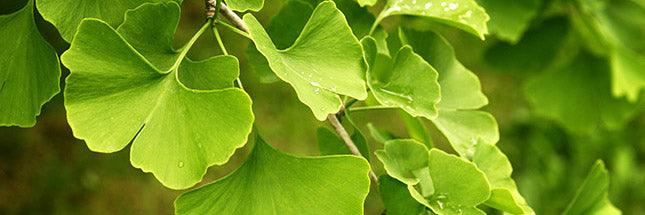QUICK FACTS
Scientific name: Ginkgo biloba
Nickname: Maidenhair tree
Location: Native to China, but grown as an ornamental tree throughout the world’s temperate zones
Known for: Longevity and resilience
Fun fact: The fruit smells of rancid butter during the ripening process
Part used: Leaf
Good for: Circulation and cognitive health
Key Properties & Actions: Anti-inflammatory, vasodilator, mild digestive bitter, cerebroprotective, nootropic
What is Ginkgo Leaf Extract?
Ginkgo — aka Maidenhair tree in England, because its leaves look similar to the maidenhair fern — is a beautiful slow-growing tree that bears clusters of fan-shaped, leathery green leaves. In the fall, these leaves turn a brilliant yellow and then fall to the ground in a matter of just two weeks, creating a vibrant gold carpet around the tree.
Growing up to 120 feet tall, the ginkgo tree can live to be about 1,000 years old. Legend has it that one ginkgo tree in China is more than 3,500 years old — no wonder it’s associated with longevity!
Ginkgo biloba extract (GBE) has long been popular in Europe, and now it has growing notoriety in the United States and other parts of the world for its neuroprotective properties and ability to aid circulatory problems, especially in the elderly. In particular, it’s used to address cerebral insufficiency (poor blood flow to the brain) and the consequent cognitive effects, peripheral circulatory impairment (particularly poor circulation to the lower legs), vertigo, and tinnitus.
Benefits of Ginkgo and How It Works
- • Healthy Blood Flow: Ginkgo promotes healthy blood flow throughout the body.1 The ability of ginkgo to improve circulation and thus blood supply appears to be due to both its vasodilating properties and its ability to reduce total blood viscosity or thickness. Ginkgo has been shown to increase blood flow throughout the body, but especially in the brain, extremities, and to the eyes.
- • Peripheral Vascular Issues: The World Health Organization (WHO) indicates that GBE may also be beneficial for specific peripheral vascular conditions such as Reynaud’s, a disease that causes persistently poor circulation to the feet and hands.8
- • Eye Health: Ginkgo is sometimes used as support for certain eye conditions related to compromised circulation, such as diabetic retinopathy.
- • Brain Health: Ginkgo supports concentration and memory, and it reduces absentmindedness and confusion. Clinical studies demonstrate that a daily dose of 120 mg to 240 mg of GBE take for 8 to 12 weeks can lead to improvement in symptoms associated with poor blood flow to the brain, such as memory loss, depression, and tinnitus.2,6
- • Reduces Fatigue: GBE helps alleviate the tiredness and decreased physical performance associated with poor tissue oxygenation that’s due to poor circulation.
- • Supports Cognitive Function: Despite some conflicting evidence in clinical studies, a growing body of evidence suggests ginkgo biloba extract is likely beneficial as a complementary therapy for degenerative cognitive conditions such as dementia and Alzheimers.3,4,5,7,9
Well over 100 scientific studies have been done on ginkgo, with at least one third of them involving human participants. See the references section below for references to selected ginkgo leaf extract studies.
History & Traditional Use
The ginkgo tree has tremendous medicinal, spiritual, and horticultural importance in Chinese culture. The tree’s leaves and fruit are used in Chinese traditional medicine to treat many diseases, and the roasted seeds are used as food.
Modern Western use of ginkgo is not derived from traditional Chinese medicine (TCM), although gingko fruit does have a long history of use in that system. New uses of ginkgo leaf extracts for cognitive and vascular conditions were introduced in the West in the 1960s, and those are still the most popular and well-researched uses of ginkgo.

The oldest tree in the world with an uninterrupted 270-million-year lineage, ginkgo is regarded as a “living fossil.” Previously thought to be an extinct group of plants, ginkgo biloba was discovered to be the sole surviving species of the phylum Ginkgophyta in the late 1600s.
Many say that Ginkgo biloba owe their existence to Buddhist monks in China, who valued, protected, and worshipped the tree in sacred temples. Later, the ginkgo tree was brought to Japan, where it was also revered and was said to help mothers become rich with milk to feed their children.
In Japan, ginkgo is known as a “survivor” and “bearer of hope” thanks to its endurance during the bombing of Hiroshima, Japan, on August 6, 1945: After the atomic bomb, four to six ginkgo trees within 1-2 km of the blast were found rooted and still alive, while all the other plants in this area died.
The surviving ginkgo trees of Hiroshima were not only able to live after the bombing, but they went on to produce buds without major distortions. These incredible trees are still alive today (2020). Parks, schools, and temples have been built around the surviving trees in an effort to remind citizens of hope.
Eventually, ginkgo was brought to other continents, including North America. Unfortunately, ginkgo can no longer be found in the wild. However, it is planted widely in cities and gardens throughout the world.
In the U.S., the ginkgo tree is most frequently found planted in cities not only for their beauty and shade, but also because of their resistance to pollutants, fungicides, insects and most insecticides, disease, bacteria, droughts, and smog.
This array of resilient and adaptive characteristics may explain why the ginkgo tree is the most widely planted tree in New York City, as well as why the ancient Chinese people thought this hardy organism must have some medicinal purposes.
How to Use and Dosing

While effects from using GBE can occur in as little as a few hours, average clinical use indicates eight weeks or more for optimal results for most people.
Ginkgo biloba extract pairs well with bacopa, ashwagandha, cat’s claw, and lion’s mane for cognitive health.
Interactions
Consult your healthcare provider before use if you are taking medications or have a medical condition. Medications and over-the-counter drugs that affect blood pressure and blood-thinning (including aspirin and NSAIDs) have theoretical potential for interactions with ginkgo, however anecdotal reports of this are extremely rare. Other potential negative herb-drug interactions include use of ginkgo with MAO inhibitors, anticoagulants, diuretics, anticonvulsants, and antidepressants.
Precautions & Side effects
Potential side effects include upset stomach, headache, allergic skin reactions, and pounding heartbeat. Ginkgo is a stimulating herb, so individuals with anxiety, insomnia, or high blood pressure should use caution if considering taking ginkgo. It’s recommended to start slowly with a half dose or less when using a supplement for the first time to allow the body to adjust and notice any potential side effects.
While there are no known contraindications for use of ginkgo with pregnancy, it’s always best to consult your healthcare advisor regarding the use of any supplement during pregnancy since theoretical concerns of ginkgo increasing bleeding risks have been noted.
Disclaimer: The information in our ingredients pages is intended as a general reference for educational purposes only and is not a replacement for professional health advice. Any mentioned dosage recommendations, safety notices, or possible interactions with prescription drugs are for educational purposes only and must be considered in the context of each individual’s health situation. Accordingly, this information should be used only under the direct supervision of a qualified healthcare practitioner.
References1. Blume, J., M. Kieser, and U. Hölscher. 1996. “[Placebo-controlled double-blind study of the effectiveness of Ginkgo biloba special extract EGb 761 in trained patients with intermittent claudication].” VASA. Zeitschrift fur Gefasskrankheiten 25 (3): 265–74.
2. Hofferberth, B. 1994. “The Efficacy of EGb 761 in Patients with Senile Dementia of the Alzheimer Type, a Double-Blind, Placebo-Controlled Study on Different Levels of Investigation.” Human Psychopharmacology: Clinical and Experimental 9 (3): 215–22. https://doi.org/10.1002/hup.470090308.
3. Kanowski, S., W. M. Herrmann, K. Stephan, W. Wierich, and R. Hörr. 1996. “Proof of Efficacy of the Ginkgo Biloba Special Extract EGb 761 in Outpatients Suffering from Mild to Moderate Primary Degenerative Dementia of the Alzheimer Type or Multi-Infarct Dementia.” Pharmacopsychiatry 29 (2): 47–56. https://doi.org/10.1055/s-2007-979544.
4. Le Bars, P. L., M. M. Katz, N. Berman, T. M. Itil, A. M. Freedman, and A. F. Schatzberg. 1997. “A Placebo-Controlled, Double-Blind, Randomized Trial of an Extract of Ginkgo Biloba for Dementia. North American EGb Study Group.” JAMA 278 (16): 1327–32. https://doi.org/10.1001/jama.278.16.1327.
5. Solfrizzi, Vincenzo, and Francesco Panza. 2015. “Plant-Based Nutraceutical Interventions against Cognitive Impairment and Dementia: Meta-Analytic Evidence of Efficacy of a Standardized Gingko Biloba Extract.” Journal of Alzheimer’s Disease: JAD 43 (2): 605–11. https://doi.org/10.3233/JAD-141887.
6. “WHO Monographs on Selected Medicinal Plants – Volume 1: Folium Ginkgo.” n.d. Accessed February 14, 2020. https://apps.who.int/medicinedocs/en/d/Js2200e/18.html.
7. Yang, Guoyan, Yuyi Wang, Jin Sun, Kang Zhang, and Jianping Liu. 2016. “Ginkgo Biloba for Mild Cognitive Impairment and Alzheimer’s Disease: A Systematic Review and Meta-Analysis of Randomized Controlled Trials.” Current Topics in Medicinal Chemistry 16 (5): 520–28. https://doi.org/10.2174/1568026615666150813143520.





